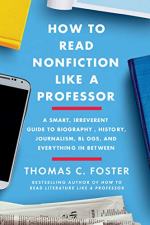
|
| Name: _________________________ | Period: ___________________ |
This test consists of 5 multiple choice questions, 5 short answer questions, and 10 short essay questions.
Multiple Choice Questions
1. In Chapter 15, "Reading Internet Sources," what does Foster call inaccurate information?
(a) Hypertext.
(b) Dark energy.
(c) Cyber-lies.
(d) Dark information.
2. In Chapter 13, "On the Stump," Foster says that a look at social media reveals what about Americans of all political persuasions?
(a) Many on both sides are strong critical thinkers.
(b) Many on both sides are blind to what makes America great.
(c) They are eager for a leader who will heal political divisions.
(d) They have lost touch with reality.
3. In Chapter 14, "The Universe of Ideas/Ideas of the Universe," what criticism does Foster level against Malcolm Gladwell?
(a) That he offers so much data it can be difficult to follow his arguments.
(b) That he tries to write outside of his own field.
(c) That he does not try to engage the reader.
(d) That he does not examine data critically enough.
4. In Chapter 12, "Life from the Inside," what advantage does Foster say contemporaneous accounts have?
(a) They allow the reader to understand the world as it is in the present.
(b) They offer a narrower--and therefore easier to understand--view of history.
(c) They allow the writer to consult sources from a variety of viewpoints.
(d) They offer a long view on historical events.
5. In Chapter 14, "The Universe of Ideas/Ideas of the Universe," what does Foster call critical reading?
(a) Scientific reading.
(b) Nonfiction evaluation.
(c) Defensive reading.
(d) Nonfiction analysis.
Short Answer Questions
1. In Chapter 10, "From the Inside Out," what type of nonfiction writing does Foster refer to as "soggy" (141), and "soul-deadening" (142)?
2. In Chapter 11, "Life from the Inside," Foster discusses the use of parallelism. He is discussing what technique?
3. In Chapter 12, "Life from the Inside," Foster discusses primary and secondary sources. Which of the following would be a secondary source about World War Two?
4. In Chapter 13, "On the Stump," which work does Foster say that Comey's book A Higher Loyalty is similar to?
5. Based on Chapter 14, "The Universe of Ideas/Ideas of the Universe," what would Foster call a neuroscientist reporting on and analyzing recent developments in neuroscience?
Short Essay Questions
1. In Chapter 10, "From the Inside Out," what characteristics does Foster say the thesis of a strong essay will have?
2. In Chapter 9, "Living the News," what two main types of subjective nonfiction does Foster define, and what four categories does he break these main types into?
3. Explain why, in Chapter 11, "Life from the Inside," Foster says that the narrators of nonfiction can be just as unreliable as the narrators of fiction.
4. In Chapter 14, "The Universe of Ideas/Ideas of the Universe," what are the three types of science writing that Foster describes, and what are the differences among them?
5. Which of the three writers that Foster discusses in Chapter 13, "On the Stump," does Foster find to be least reliable, and which does he find to be most reliable? Why is this?
6. In Chapter 10, "From the Inside Out," what does Foster list as the three criteria of Ezra Pound's criticism?
7. In Chapter 14, "The Universe of Ideas/Ideas of the Universe," what does Foster say motivates antiscientific beliefs?
8. In Chapter 15, "Reading Internet Sources," what does Foster propose as a solution to inaccuracies on the web?
9. In Chapter 11, "Life from the Inside," what does Foster say is the difference between autobiography and memoir?
10. In Chapter 13, "On the Stump," what concern does Foster say that other journalists have about Wolff's work?
|
This section contains 1,018 words (approx. 4 pages at 300 words per page) |

|




